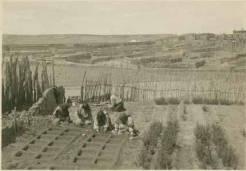by Darcy Brazen, Digital Hillerman Fellow
Originally published on Celebrating New Mexico Statehood, 7/31/2017
One of my designated duties as a digital initiatives fellow involves the researching and writing authentic definitions for Tony Hillerman's children's story The Boy Who Made Dragonfly. The setting is the ancient village of Ha'wi-k'uh where the Zuni or A'shiwi people still live today. Adopted from ethnologist Frank Cushing's retelling of this A'shiwi tale, its cautionary tone warns against wanton wastefulness and stresses the importance of caring for one's neighbors. Hillerman's introduction situates the work within the cultural tradition of dramatic Christian origin stories as told in Genesis, the first chapter of the Bible.
I would argue that The Boy is a morality tale. In the rapidly-emerging secular societies of the 15th and 16th-century medieval Tudors, the morality play was known as an interlude. Emphasis is placed on abstract concepts like beauty, knowledge, and justice with the ultimate goal of receiving godly redemption. This formal staged drama involved a hero protagonist and a cast of human characters embodying good and evil.
For the Native Americas, from Inuit to Cree to Zuni, morality tales encompass an oral tradition transmitting cultural values via personified animal, and even inanimate, beings of the natural world emphasizing the importance of benevolent imperatives like patience, appreciation, and generosity. The moral or folk tale allows for a deep and nuanced understanding of social and familial values. In the Inuit world, the moon almost never turns to face his sister the sun for he is ashamed because on earth he abused his sister. The lesson is that perpetrators of violence in the community will be turned away. In The Boy, the boy is the caretaker of his sister and the elderly. Rewarded for his efforts, he gains spiritual knowledge from the dragonfly and recognition as a community leader. The boy is a savior who saves the community through individual trial and tribulation.
Hillerman's narrative hinges on the isolation of the boy and his sister as they are stranded and starving through the long winter months in Ha'wi-k'uh, unaware of even the old woman living there. I question the authenticity of this detail so crucial to Mr. Hillerman's account of this Zuni story: the depiction of the Zuni heroes and heroines of the tale preparing and eating food in their individuated chambers apart from the larger community.
The Zuni photographic record of the 1880s, digitally available through the Hillerman portal and UNM's Center for Southwest Research on-line archival base, suggest that food was a very communal and lively affair. The archives buzz with images of Zuni life as women gather to grind corn, and men loaded burrros and tended the famed waffle gardens. As male workers filed in from the fields at dusk, women greeted them by lining up steaming bowls of stew glistening with red chile along the rooftops, along with the delicate red and blue-hued corn crackers that Cushing deemed "breadstuff."
Despite this mild critique, Hillerman's portrait of winter in Ha'wi-k'uh is a gripping story of heroism in the face of adversity a millennium ago. Its relevance and context is now greatly enhanced by access to on-line archival data bases available through the Center for Southwest Research and the Tony Hillerman electronic portal at the University of New Mexico.
We appreciate our staff and readers! Thanks to the Hillerman family and DISC staff Kevin Comerford, Emily Cammack and Amy Winter. May we all have a month of joy, patience, and understanding.
(Photo: Tending Waffle Gardens, Jesse Neubaum, 008740; Palace of the Governors Photo Archives, New Mexico Museum of History.)

